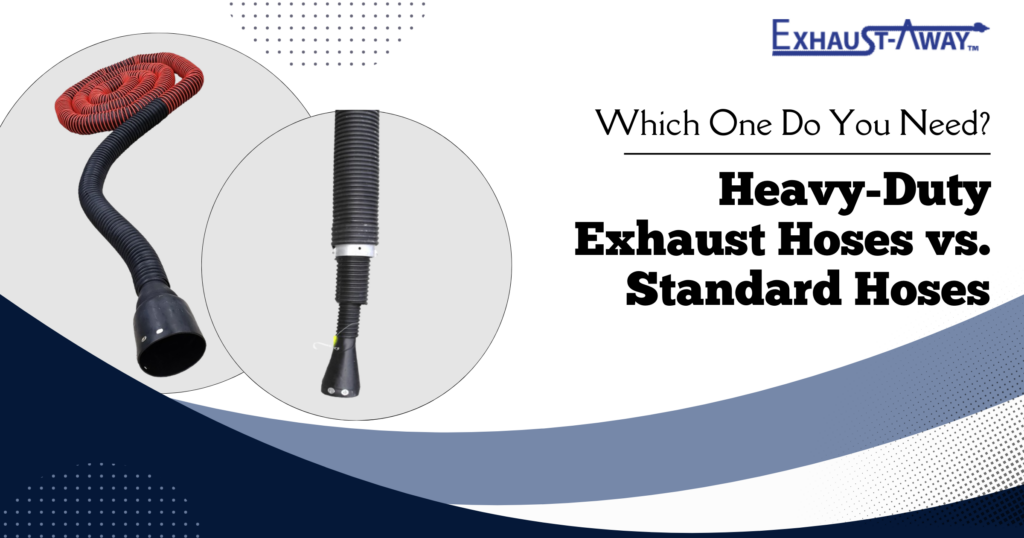Exhaust hoses are crucial components in various industries, including automotive, industrial, marine, and emergency services. They play a vital role in safely channeling harmful exhaust gases away from work areas, ensuring a safe and healthy environment for personnel. Designed to withstand high temperatures, harsh operating environments, toxic gases, and so on, these hoses prevent the release of fumes directly into the atmosphere, thereby maintaining air quality and adhering to safety regulations. Selecting the right type of hose is necessary to avoid premature wear, safety hazards, and operational inefficiencies. For instance, using a standard hose in a high-temperature application may result in hose failure, posing risks to both equipment and personnel. This post delves into the key differences between standard and heavy-duty exhaust hoses and guides you on when to opt for heavy-duty over standard exhaust hoses.

Key Differences Between Standard and Heavy-Duty Exhaust Hoses
Understanding the differences between standard and heavy-duty exhaust hoses is crucial for making the right choice based on specific operational needs. While both types serve similar purposes, they differ significantly in construction, durability, and application suitability.
- Temperature Resistance: Standard exhaust hoses are designed for moderate-temperature applications, such as light automotive repair shops and general ventilation systems. They typically handle temperatures up to 600°F, making them suitable for basic exhaust removal. However, heavy-duty exhaust hoses are built to endure extreme heat levels, often exceeding 1000°F. Industries such as marine engineering and heavy industrial sectors require flarelok exhaust hoses and flexible exhaust hoses that can sustain high-heat environments without degrading or melting.
- Flexibility and Durability: Standard hoses are lightweight and flexible, making them ideal for applications requiring frequent movement or adjustment. However, they may lack the reinforcement needed for heavy-duty industrial use. Heavy-duty hoses, on the other hand, are constructed with reinforced layers, allowing them to withstand continuous stress, high pressure, and repeated exposure to extreme temperatures. Their added durability ensures they do not easily crack, break, or collapse under high-intensity applications.
- Material Differences: Standard hoses are often made from lightweight rubber, PVC, or simple composites, offering a cost-effective solution for less demanding environments. Heavy-duty exhaust hoses, in contrast, utilize materials such as high-grade silicone, metal-reinforced rubber, or thermoplastic elastomers, providing superior resistance to abrasion, chemicals, and extreme temperatures. ACT exhaust hoses in heavy-duty configurations feature advanced thermal insulation properties to enhance longevity.
- Pressure Handling Capability: Standard hoses operate well under low to moderate pressure, making them ideal for less aggressive exhaust extraction. Heavy-duty hoses, however, are reinforced with additional layers, allowing them to withstand extreme pressure fluctuations without the risk of collapsing or bursting.
When to Choose Heavy-Duty Over Standard Exhaust Hoses?
Determining whether you need a heavy-duty exhaust hose depends on various operational factors. While standard hoses may be sufficient for low-intensity applications, there are scenarios where only a heavy-duty hose will suffice.
- High-Temperature Exhaust Systems: If your application involves engines, furnaces, or industrial exhaust systems that generate extreme heat, a heavy-duty exhaust hose is a must. These hoses are built to endure sustained exposure to high temperatures without melting, warping, or cracking.
- Industrial and Heavy Equipment Applications: Standard hoses may struggle in large-scale industries such as mining, steel manufacturing, and power generation. Heavy-duty hoses durable enough to handle continuous operation, while maintaining efficient exhaust extraction.
- Marine and Ship Exhaust Systems: Marine applications demand hoses that can withstand not only high temperatures but also saltwater exposure and extreme weather conditions. Heavy-duty exhaust hoses reinforced with corrosion-resistant materials are ideal for these challenging environments.
- Continuous or Heavy Usage Environments: If an exhaust system is used frequently or continuously, such as in large repair facilities or industrial plants, heavy-duty hoses provide a longer lifespan and better efficiency compared to standard hoses, reducing the need for frequent replacements.
Worried about choosing the right exhaust hose? At Exhaust Away, we offer durable and flexible heavy-duty and standard exhaust hoses to ensure optimal performance for your needs. Whether you need extra durability for high-heat applications or a standard hose for lighter use, we have got you covered! If you have customization requests or questions, contact our sales team today and get the perfect fit for your system.